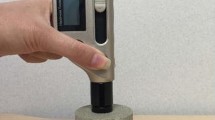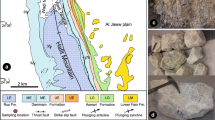Abstract
The strength of intact rock is a fundamental and integral part of many aspects of engineering and geologic practice. It is necessary to understand how testing conditions influence this strength and its variability, especially for use in reliability-based design. In this study, the effect of sample diameter and moisture content on the strength and its variability was examined in detail. Correlations are given for assessing the effect of sample diameter on the laboratory uniaxial compressive strength (qu), Brazilian indirect tensile strength (qt-Brazilian), and point load strength (Is), and the associated direct correlations among these tests. Correlations also are given for assessing the effect of sample moisture content on qu, qt-Brazilian, and Is. The statistics of data scatter suggest these correlations can introduce large uncertainties. The effect of sample diameter and moisture content on the coefficients of variation was examined subsequently, and it was found to be relatively minor.















Similar content being viewed by others
References
Abou-Sayed AS, Brechtel CE (1976) Experimental investigation of the effects of size on the uniaxial strength of Cedar City quartz diorite. In: 17th US symposium on rock mechanics, Snowbird, pp 5 D6 1-9
American Society for Testing and Materials (2008a) Standard test method for determination of the point load strength index of rock and application to rock strength classifications (D5731). Annual Book of Standards 04.08, ASTM, Philadelphia
American Society for Testing and Materials (2008b) Standard practices for preparing rock core as cylindrical test specimens and verifying conformance to dimensional and shape tolerances (D4543). Annual Book of Standards 04.08, ASTM, Philadelphia
Bagde MN (2002) An investigation into strength and porous properties of metamorphic rocks in the Himalayas: a case study. Geotech Geol Eng 18:209–219
Beavis FC, Roberts FI, Minskaya L (1982) Engineering aspects of weathering of low grade metapelites in an arid climatic zone. Q J Eng Geol 15–1:29–45
Bell FG (1977) A note on the physical properties of chalk. Eng Geol 11–3:217–225
Bell FG (1978) The physical and mechanical properties of the Fell sandstones, Northumberland, England. Eng Geol 12–1:1–29
Bell FG (1981a) A survey of the physical properties of some carbonate rocks. Bull Eng Geol Environ 24–1:105–110
Bell FG (1981b) Geotechnical properties of some evaporitic rocks. Bull Eng Geol Environ 24–1:137–144
Bell FG, Culshaw MG (1990) A survey of the geotechnical properties of some relatively weak Triassic. In: Cripps JC, Coulthard JM, Culshaw MG, Forster A, Hencher SR, Moon CF (eds) Engineering geology of weak rock, Leeds, pp 139–148
Bell FG, Culshaw MG (1998) Petrographic and engineering properties of sandstones from the Sneinton formation, Nottinghamshire, England. Q J Eng Geol 31–1:5–19
Bell FG, Culshaw MG, Cripps JC (1999) A review of selected engineering geological characteristics of English chalk. Eng Geol 54–3:237–269
Bieniawski ZT (1975) The point-load test in geotechnical practice. Eng Geol 9–1:1–11
Broch E (1983) Estimation of strength anisotropy using the point-load test. Int J Rock Mech Min Sci Geomech Abstr 20–4:181–187
Broch E, Franklin JA (1972) The point-load strength test. Int J Rock Mech Min Sci Geomech Abstr 9–6:669–697
Cargill JS, Shakoor A (1990) Evaluation of empirical methods for measuring the uniaxial compressive strength of rock. Int J Rock Mech Min Sci Geomech Abstr 27–6:495–503
Dearman WR, Irfan TY (1978) Classification and index properties of weathered coarse-grained granites from South-West England. In: 3rd international congress of international association of engineering geology, Madrid, pp 119–130
Forster IR (1983) The influence of core sample geometry on the axial point-load test. Int J Rock Mech Min Sci Geomech Abstr 20–6:291–295
Ghosh A, Fuenkajorn K, Daemen JJK (1995) Tensile strength of welded Apache Leap tuff: investigation of scale effects. In: 17th US symposium on rock mechanics, Snowbird, pp 459–464
Gunsallus KL, Kulhawy FH (1984) A comparative evaluation of rock strength measures. Int J Rock Mech Min Sci Geomech Abstr 21–5:233–248
Gupta AS, Rao KS (1998) Index properties of weathered rocks: inter-relationships and applicability. Bull Eng Geol Environ 57–2:161–172
Hassani FP, Scoble MJ, Whittaker BN (1980) Application of the point load index test to strength determination of rock and proposals for a new size-correlation chart. In: 21st US symposium on rock mechanics, Rolla, pp 543–553
Hawkins AB (1998) Aspects of rock strength. Bull Eng Geol Environ 57–1:17–30
Hoek E, Brown ET (1980) Underground excavations in rock: Institution of Mining and Metallurgy, London, 527 p
Howarth DF (1987) The effect of pre-existing microcavities on mechanical rock performance in sedimentary and crystalline rocks. Int J Rock Mech Min Sci Geomech Abstr 24–4:223–233
Hudson JA, Brown ET, Fairhurst C (1971) Shape of the complete stress-strain curve for rock. In: 12th US symposium on rock mechanics, Urbana, pp 773–795
Kulhawy FH (1992) On evaluation of static soil properties. In: Seed RB, Boulanger RW (eds) Stab and perform of slopes and embankments II (GSP 31). ASCE, New York, pp 95–115
Kulhawy FH, Prakoso WA (2001) Foundations in carbonate rocks & karst. In: Brandon TL (ed) Found & ground improv (GSP 113), ASCE, 1–15
Lock Y-B (1996) An examination of failure criteria for some common rock in Hong Kong. M.Phil. Thesis, University of Hong Kong
Lundborg N (1967) The strength-size relation of granite. Int J Rock Mech Min Sci Geomech Abstr 4–3:269–272
Miller RP (1965) Engineering classification and index properties for intact rock. Ph.D. Dissertation, University of Illinois
Onodera TF, Asoka-Kumara HM (1980) Relation between texture and mechanical properties of crystalline rocks. Bull Eng Geol Environ 22–1:173–177
Panek LA, Fannon TA (1992) Size and shape effects in point load tests of irregular rock fragments. Rock Mech Rock Eng 25–2:109–140
Phoon K-K, Kulhawy FH (1999) Evaluation of geotechnical property variability. Can Geotech J 36–4:625–639
Rao KS, Rao GV, Ramamurthy T (1987) Discussion on “A comparative evaluation of rock strength measures”. Int J Rock Mech Min Sci Geomech Abstr 24–3:193–196
Schultz RA, Li Q (1995) Uniaxial strength testing of non-welded Calico Hills tuff, Yucca-Mountain, Nevada. Eng Geol 40–3(4):287–299
Tugrul A, Gurpinar O (1997) A proposed weathering classification for basalts and their engineering properties (Turkey). Bull Eng Geol Environ 55–1:139–149
Tugrul A, Zarif IH (2000) Engineering aspects of limestone weathering in Istanbul, Turkey. Bull Eng Geol Environ 58–3:191–206
Turgut P, Yesilnacar MI, Bulut H (2008) Physico-thermal and mechanical properties of Sanliurfa limestone, Turkey. Bull Eng Geol Environ 67–4:485–490
Yamaguchi U (1970) The number of test-pieces required to determine the strength of rock. Int J Rock Mech Min Sci Geomech Abstr 7–2:209–227
Yilmaz I (2007) Differences in the geotechnical properties of two types of gypsum: alabastrine and porphyritic. Bull Eng Geol Environ 66–2:187–195
Author information
Authors and Affiliations
Corresponding author
Rights and permissions
About this article
Cite this article
Prakoso, W.A., Kulhawy, F.H. Effects of Testing Conditions on Intact Rock Strength and Variability. Geotech Geol Eng 29, 101–111 (2011). https://doi.org/10.1007/s10706-010-9356-y
Received:
Accepted:
Published:
Issue Date:
DOI: https://doi.org/10.1007/s10706-010-9356-y




